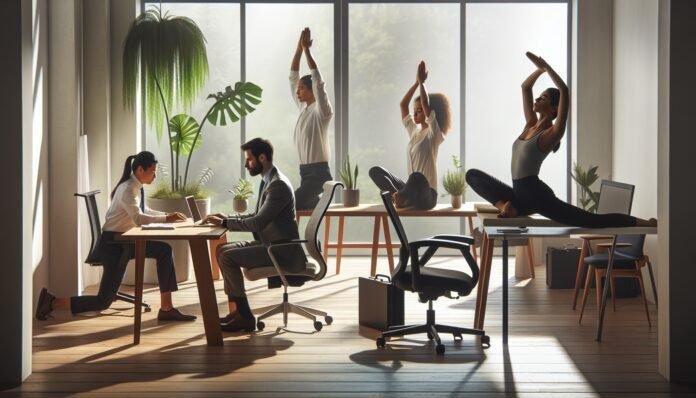Desk yoga sequences offer simple and effective stretches designed to combat the negative effects of prolonged sitting. Studies show that sitting for extended periods can increase stress, stiffness, and fatigue, making it crucial to find ways to stay active during work hours. This guide explores gentle stretches that can be performed at your desk, helping to improve flexibility, reduce tension, and boost overall well-being. Whether you’re managing deadlines or tackling long meetings, these desk-friendly moves are easy to incorporate into your routine, keeping your body energized and focused throughout the day.
Benefits of Desk Yoga for Office Workers
Desk Yoga offers a multitude of benefits for office workers, transforming the typical workday into a more mindful and health-oriented experience. Daily work routines can be taxing on the body, leading to discomfort and stress. Integrating Desk Yoga Sequences into your day promotes flexibility, enhances mental well-being, and counters the negative effects of prolonged sitting. This section explores the key benefits of incorporating desk yoga into your work routine.
How Desk Yoga Enhances Flexibility and Reduces Stiffness
Desk jobs often lead to stiffness and reduced flexibility due to prolonged sitting. Desk Yoga serves as a revitalizing solution, encouraging movement and stretching within a limited space. Regular practice helps maintain joint mobility and muscle flexibility, targeting the neck, shoulders, back, and hips.
- Increased Range of Motion: Desk Yoga exercises promote a wider range of motion, making everyday movements easier and more fluid.
- Reduced Muscle Tension: Targeted stretches help alleviate tension, reducing the risk of strain and injury.
- Improved Circulation: Gentle movements stimulate blood flow, enhancing oxygen delivery to the muscles and reducing the feeling of stiffness.
Mental Health Benefits of Incorporating Desk Yoga During Work
Desk Yoga offers more than physical benefits—it significantly contributes to mental well-being. Integrating mindful movements and breathing exercises throughout the day can alleviate stress and improve concentration.
- Stress Reduction: Focused breathing and movement calm the nervous system, reducing anxiety and promoting a sense of relaxation.
- Enhanced Focus and Productivity: Regular breaks for yoga refresh the mind, improving attention and efficiency.
- Mood Enhancement: The practice of yoga releases endorphins, enhancing mood and overall mental health.
Combating Fatigue and Improving Posture With Desk Stretches
Fatigue and poor posture are common complaints among office workers. Desk Yoga provides simple yet effective stretches to combat these issues, ensuring you feel energized and maintain proper alignment.
- Energy Boost: Quick stretches invigorate the body, combating the afternoon slump and boosting energy.
- Postural Awareness: Yoga encourages mindfulness of posture, promoting spine alignment and reducing back and neck pain.
- Muscle Engagement: Regular practice strengthens core and back muscles, supporting better posture.
Simple Desk Yoga Stretches to Combat Prolonged Sitting
Prolonged sitting can have detrimental effects on both physical and mental health. Desk Yoga provides simple yet effective stretches to counteract these effects, making it easier to incorporate movement into your busy workday. These stretches are designed to be performed at your desk, no matter how limited the space.
Seated Spinal Twist to Improve Back Mobility
The seated spinal twist is a powerful stretch that enhances spinal mobility and relieves tension in the back. This pose is perfect for office workers, providing an invigorating break from desk work.
- Benefits:
- Releases tension in the lower back
- Enhances spinal mobility
- Improves digestion through gentle abdominal compression
- How to Perform:
- Sit upright with feet flat on the floor.
- Place your right hand behind your hip.
- Inhale, lengthen the spine, and twist to the right.
- Hold for a few breaths before switching sides.
Neck and Shoulder Rolls for Stress Relief
Neck and shoulder tension are common issues for office workers. Simple neck and shoulder rolls can relieve stress and improve flexibility in these areas.
- Benefits:
- Relieves tension and stress in the neck and shoulders
- Increases range of motion
- Enhances relaxation and reduces headache frequency
- How to Perform:
- Sit comfortably with your spine straight.
- Slowly drop your chin towards your chest.
- Roll your head to the right shoulder, then back, and to the left shoulder.
- Repeat several times, then reverse the direction.
Wrist and Finger Stretches to Ease Typing Strain
Typing and computer work can lead to wrist and finger strain. Desk Yoga offers quick stretches to alleviate discomfort and prevent injury.
- Benefits:
- Alleviates strain from prolonged typing
- Increases flexibility in wrists and fingers
- Reduces risk of repetitive strain injuries
- How to Perform:
- Extend your right arm, palm facing up, and gently pull back your fingers with your left hand.
- Hold for a few seconds, then switch hands.
- Interlace fingers, stretch arms forward, palms out, and hold.
Tips for Incorporating Desk Yoga Into Your Daily Work Routine
Incorporating Desk Yoga into your daily routine can transform your work experience, enhancing both physical and mental well-being. Here are practical tips for seamlessly integrating yoga into your workday, ensuring consistent practice and maximum benefits.
Setting Reminders and Scheduling Yoga Breaks
Consistency is key when integrating Desk Yoga into your routine. Setting reminders and scheduling regular breaks can help make yoga a natural part of your workday.
- Use Technology: Set alarms or calendar reminders to prompt you to take yoga breaks.
- Dedicated Time Slots: Schedule specific times throughout the day for short yoga sessions, similar to scheduling meetings.
- Start Small: Begin with short, 5-minute sessions and gradually increase as it becomes a habit.
Modifying Desk Yoga Poses for Small Office Spaces
Limited office space doesn’t have to hinder your yoga practice. Many Desk Yoga poses can be modified to fit smaller areas, allowing you to practice regardless of your workspace constraints.
- Chair-Based Poses: Opt for poses that can be performed while seated.
- Standing Poses: Utilize standing positions like chair pose or tree pose, which require minimal space.
- Creative Use of Space: Use the back of your chair or a wall for support to maximize the usability of your space.
Combining Breathing Techniques With Gentle Stretches for Maximum Effect
Integrating breathing techniques with your Desk Yoga practice enhances the benefits, creating a more holistic and effective routine. Focused breathing can deepen the effects of stretches, promoting relaxation and mindfulness.
- Deep Breathing: Combine stretches with deep, controlled breaths to enhance relaxation and focus.
- Mindful Breathing: Practice mindfulness by focusing on your breath during each stretch, enhancing the mind-body connection.
- Breath Synchronization: Align your movements with your breathing, inhaling to lengthen and exhaling to deepen stretches.
Conclusion
Get Desk Yoga improves physical flexibility, reduces stiffness, and alleviates muscle tension caused by prolonged sitting. It enhances mental well-being by reducing stress, boosting focus, and improving mood through mindful movements and breathing exercises. Simple stretches like spinal twists, neck rolls, and wrist stretches address back, neck, and typing strain effectively. Regular practice combats fatigue, enhances posture, and strengthens muscle engagement for better alignment. Scheduling yoga breaks, using small office spaces creatively, and combining breathing techniques with stretches ensure easy integration into the workday.
FAQ
What are the benefits of practicing desk yoga during work hours?
Desk yoga promotes flexibility, reduces stress, and increases focus. It helps in relieving tension in muscles that get strained from prolonged sitting. Regular practice enhances overall well-being, making work hours more productive and less stressful.
How often should you do desk yoga for maximum health benefits?
Incorporating desk yoga into your routine two to three times a day can yield significant health benefits. Even short sessions of 5-10 minutes can improve circulation, reduce muscle tension, and boost mental clarity.
Can desk yoga help with neck and shoulder pain from sitting?
Yes, desk yoga offers stretches and movements that specifically target neck and shoulder areas. This practice can alleviate pain caused by poor posture and continuous sitting, providing relief and improving mobility.
What are some simple desk yoga poses for beginners?
Begin with seated spinal twists, neck rolls, and shoulder shrugs. These poses are easy to perform at your desk and require no special equipment. They help in releasing tension and promoting relaxation.
How can desk yoga improve posture for office workers?
Regularly practicing desk yoga encourages proper alignment of the spine and shoulders. It strengthens core muscles and teaches awareness of body positioning, which is essential for maintaining good posture.
Is desk yoga effective in reducing workplace stress and tension?
Absolutely, desk yoga reduces workplace stress by encouraging mindful breathing and movement. It helps in calming the mind, releasing physical tension, and fostering a more relaxed work environment.




